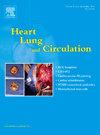Unilateral Chronic Thromboembolic Pulmonary Disease: Do Patients Benefit From Thromboendarterectomy? Case Series From Three CTEPH Centres
IF 2.2
4区 医学
Q2 CARDIAC & CARDIOVASCULAR SYSTEMS
引用次数: 0
Abstract
Background
Unilateral chronic thromboembolism pulmonary disease (CTEPD) is very rare. There is limited information on the safety and efficacy of pulmonary endarterectomy (PEA) in this population. This study investigated the effectiveness of PEA in this unique disease.
Methods
This multicentre study included patients with unilateral CTEPD from three referral centres in the United States, Turkey, and Iran. The patients’ demographic information, 6-minute walk test distance (6MWD), New York Heart Association (NYHA) functional class, and haemodynamics were evaluated.
Result
Of the 1,031 patients who had undergone PEA, 39 patients (3.7%) had pure unilateral involvement, of whom 28 were female (71.8%). There was a significant improvement in the mean pulmonary artery pressure (mPAP, 26 mmHg vs 21 mmHg; p=0.011) and pulmonary vascular resistance (PVR, 202 vs 136 dynes∗sec1∗cm-5; p=0.014). There was also a significant improvement in NYHA functional class (p<0.001) and 6MWD (360 vs 409 m; p<0.001). In the nine patients with normal haemodynamic parameters at rest, there was no significant change in median 6MWD (448.5 vs 449 m; p=0.208), mPAP (19 mmHg vs 16.5 mmHg; p=0.397), and PVR (129 vs 84.5 dynes∗sec1∗cm-5; p=0.128). The most common postoperative complication was ipsilateral pleural effusion. One patient needed extracorporeal membrane oxygenation support. No patient died within the 1-year follow up.
Conclusion
Pulmonary endarterectomy is a safe and effective procedure for improving the symptoms and haemodynamic parameters of patients with unilateral CTEPH. Symptomatic patients with unilateral chronic thromboembolic disease are suitable for PEA.
单侧慢性血栓栓塞性肺病:患者是否受益于血栓内膜切除术?来自三个 CTEPH 中心的病例系列。
背景:单侧慢性血栓栓塞性肺病(CTEPD)非常罕见:单侧慢性血栓栓塞性肺病(CTEPD)非常罕见。关于肺动脉内膜剥脱术(PEA)在这一人群中的安全性和有效性的信息非常有限。本研究探讨了肺动脉内膜剥脱术(PEA)在这种特殊疾病中的有效性:这项多中心研究纳入了来自美国、土耳其和伊朗三个转诊中心的单侧 CTEPD 患者。对患者的人口统计学信息、6 分钟步行测试距离(6MWD)、纽约心脏协会(NYHA)功能分级和血液动力学进行了评估:在 1031 名接受过 PEA 的患者中,39 名患者(3.7%)为纯粹的单侧受累,其中 28 名为女性(71.8%)。平均肺动脉压(mPAP,26 mmHg vs 21 mmHg;P=0.011)和肺血管阻力(PVR,202 vs 136 dynes∗sec1∗cm-5;P=0.014)均有明显改善。NYHA 功能分级也有明显改善(p1∗cm-5;p=0.128)。最常见的术后并发症是同侧胸腔积液。一名患者需要体外膜氧合支持。在一年的随访中,没有患者死亡:肺动脉内膜剥脱术是一种安全有效的手术,可改善单侧 CTEPH 患者的症状和血流动力学参数。有症状的单侧慢性血栓栓塞性疾病患者适合接受肺动脉内膜剥脱术。
本文章由计算机程序翻译,如有差异,请以英文原文为准。
求助全文
约1分钟内获得全文
求助全文
来源期刊

Heart, Lung and Circulation
CARDIAC & CARDIOVASCULAR SYSTEMS-
CiteScore
4.50
自引率
3.80%
发文量
912
审稿时长
11.9 weeks
期刊介绍:
Heart, Lung and Circulation publishes articles integrating clinical and research activities in the fields of basic cardiovascular science, clinical cardiology and cardiac surgery, with a focus on emerging issues in cardiovascular disease. The journal promotes multidisciplinary dialogue between cardiologists, cardiothoracic surgeons, cardio-pulmonary physicians and cardiovascular scientists.
 求助内容:
求助内容: 应助结果提醒方式:
应助结果提醒方式:


